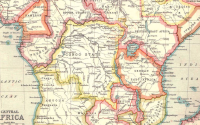12 December 2006Jonathan Amos
A new model forecasts largely ice-free summers by 2040 |
The latest data presented at the American Geophysical Union Fall Meeting suggests the ice is no longer showing a robust recovery from the summer melt.
Last month, the sea that was frozen covered an area that was two million sq km less than the historical average.
"That's an area the size of Alaska," said leading ice expert Mark Serreze.
"We're no longer recovering well in autumn anymore. The ice pack may now be starting to get preconditioned, perhaps to show very rapid losses in the near future," the University of Colorado researcher added.
The sea ice reached its minimum extent this year on 14 September, making 2006 the fourth lowest on record in 29 years of satellite record-keeping and just shy of the all time minimum of 2005.
'Feedback loop'
Dr Serreze's concern was underlined by new computer modelling which concludes that the Arctic may be free of all summer ice by as early as 2040.
The new study, by a team of scientists from the National Center for Atmospheric Research (NCAR), the University of Washington, and McGill University, found that the ice system could be being weakened to such a degree by global warming that it soon accelerates its own decline.
"As the ice retreats, the ocean transports more heat to the Arctic and the open water absorbs more sunlight, further accelerating the rate of warming and leading to the loss of more ice," explained Dr Marika Holland.
"This is a positive feedback loop with dramatic implications for the entire Arctic region."
Eventually, she said, the system would be "kicked over the edge", probably not even by a dramatic event but by one year slightly warmer than normal. Very rapid retreat would then follow.
Locally, this would have major consequences for wildlife in the region, not least polar bears which traverse ice-floes in search of food.
Loss of summer ice would seriously compromise the lifestyles of the region's indigenous peoples, though it could also bring new trading opportunities as sea routes opened up.
On a global scale, the Earth would lose a major reflective surface and so absorb more solar energy, potentially accelerating climatic change across the world.
Sooner or later
In one of the model's simulations, the September ice was seen to shrink from about 5.9 million sq km (2.3 million sq miles) to 1.9 million sq km (770,000 square miles) in just a 10-year period.
By 2040, only a small amount of perennial sea ice remained along the north coasts of Greenland and Canada, while most of the Arctic basin was ice-free in September.
"We don't think that state has existed for hundreds of thousands of years; this is a dramatic change to the Arctic climate system," Dr Holland told the BBC.
Dr Serreze, who is not a modeller and deals with observational data, feels the tipping point could be very close.
"My gut feeling is that it might be around the year 2030 that we really see a rapid decline of that ice. Now could it occur sooner? It might well. Could it occur later? It might well.
"It depends on the aspects of natural variability in the system. We have to remember under greenhouse warming, natural variability has always been part of the picture and it always will be part of the picture."
The average sea ice extent for the entire month of September this year was 5.9 million sq km (2.3 million sq miles). Including 2006, the September rate of sea ice decline is now approximately -8.59% per decade, or 60,421 sq km (23,328 sq miles) per year.
At that rate, without the acceleration seen in the new modelling, the Arctic Ocean would have no ice in September by the year 2060.







